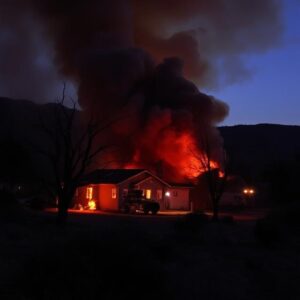Abandoned houses with fire damage often become safety hazards and targets for vandalism. Boarding up a house after a fire is a crucial step toward protecting the property, whether homeowners are considering repairs or putting the fire-damaged house on sale. This process secures the structure, mitigates further damage, and ensures compliance with local safety regulations. With fires becoming more frequent across the U.S., especially in fire-prone states like California, understanding how to secure these homes is more essential than ever.
Why Boarding Up Is Necessary
Boarding up the house not only protects the property but also preserves its value if you plan to list the fire-damaged home for sale.
Tools and Materials You’ll Need
Before boarding up a house or any other building following a fire, gather your tools and materials to perform this task with efficiency. Here’s a quick checklist for what you’ll need:
- Plywood Sheets: At least ½ to ¾ inch thick for sturdy protection.
- Power Drill and Screws: To secure the boards in place.
- Measuring Tape: Ensure precise cuts for windows and doors.
- Saw or Circular Cutter: Helps cut the plywood to fit openings.
- Ladders and Gloves: For safety while working at heights.
- Heavy-Duty Nails or Screws: Only use materials that can hold under stress from weather or attempts to remove the boards.
Tried to have a proper set of tools and materials. This was to avoid expensive errors that might affect your decking’s strength.
Step-by-Step Guide to Board Up a House
1. Assess the Structural Stability
Performing a thorough inspection of the structure is the primary thing to perform before boarding up the house after the fire damage. You should look for weak walls, unstable roof sections, and other signs of compromise. In the event that the house feels unsafe, consult a professional structural engineer or fire restoration team before proceeding.
2. Measure and Cut Plywood
Carefully measure all windows, doors, and large openings. Add an extra inch or two around so that they can truly protect against break-ins or damage from weather. After measuring, the sheets of plywood can be cut on-site with a circular saw for a snug fit.
3. Cover Windows First
Windows are typically the most vulnerable parts of a fire-damaged house. Position the cut plywood over the window frame and secure it with screws or nails at regular intervals. Heavy-duty screws are more resistant to tampering compared to nails, which can be pried loose more easily.
4. Secure Doors and Other Entry Points
For doors, replace any damaged parts, and board them up completely. Multiple screws should be used along the perimeter to ensure the board cannot be easily removed. The smaller entry points, like vents, must be blocked to avoid entry.
5. Seal Large Openings
In the event that the fire has caused structural breaches wide enough, an application of overlapping plywood or tie rod systems should be used for securing such. Aside from these larger areas, beams or special bracing would be required for a good reinforcement. Close these gaps at the earliest opportunity to minimize exposure to bad weather or pests.
6. Consult Local Codes
Different municipalities have their own specific building codes and regulations regarding boarding up properties. Make sure you investigate these to avoid legal issues or fines. Moreover, securing your home according to code may help with damage claims with your insurance.
Tying It All Together
Boarding up a house after a fire doesn’t just secure the property; it plays a critical role in helping you recover financially. Fire-damaged homes for sale that have been properly secured often sell for a higher price because buyers see the effort to maintain the property’s condition.
For instance, after the Eaton Fire in California, realtors noted a significant price difference between homes proactively secured by owners versus those left exposed. Safe and secure properties give would-be buyers the assurance that the damage has been adequately managed and that there is no further deterioration.

Additional Tips for Protecting Fire-Damaged Homes
Here are some extra precautions to consider if you’re managing a fire-damaged property:
- Install Motion Sensors: Boost security by adding motion-triggered lights or cameras to help scare away intruders.
- Temporary Fencing: Fencing off the perimeter can serve as an added barrier.
- Address Hazards Quickly: Additional permits may be necessary to perform the repairs stipulated by the code officer and the building inspector.